Early Intervention for Autism Spectrum Disorder
VerifiedAdded on 2020/05/28
|8
|2660
|316
AI Summary
This assignment presents a research proposal investigating the benefits of early intervention for children diagnosed with Autism Spectrum Disorder (ASD). It emphasizes the importance of professional guidance for parents and outlines a study design involving control and experimental groups. The proposal focuses on implementing interventions like outdoor sports, extracurricular activities, medication, and physical exercise to improve the quality of life for ASD children. The research aims to assess the effectiveness of these interventions by comparing outcomes between the groups.
Contribute Materials
Your contribution can guide someone’s learning journey. Share your
documents today.
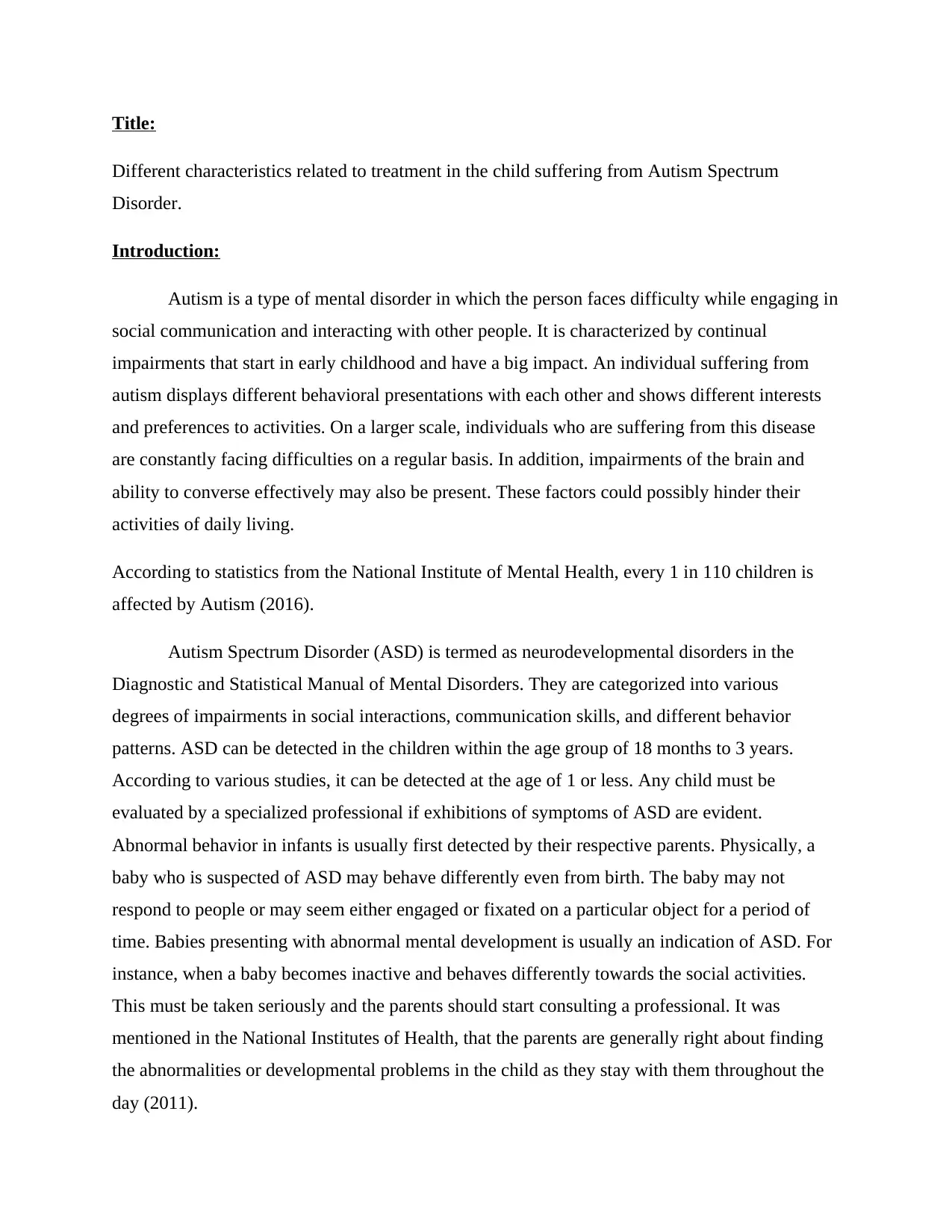
Title:
Different characteristics related to treatment in the child suffering from Autism Spectrum
Disorder.
Introduction:
Autism is a type of mental disorder in which the person faces difficulty while engaging in
social communication and interacting with other people. It is characterized by continual
impairments that start in early childhood and have a big impact. An individual suffering from
autism displays different behavioral presentations with each other and shows different interests
and preferences to activities. On a larger scale, individuals who are suffering from this disease
are constantly facing difficulties on a regular basis. In addition, impairments of the brain and
ability to converse effectively may also be present. These factors could possibly hinder their
activities of daily living.
According to statistics from the National Institute of Mental Health, every 1 in 110 children is
affected by Autism (2016).
Autism Spectrum Disorder (ASD) is termed as neurodevelopmental disorders in the
Diagnostic and Statistical Manual of Mental Disorders. They are categorized into various
degrees of impairments in social interactions, communication skills, and different behavior
patterns. ASD can be detected in the children within the age group of 18 months to 3 years.
According to various studies, it can be detected at the age of 1 or less. Any child must be
evaluated by a specialized professional if exhibitions of symptoms of ASD are evident.
Abnormal behavior in infants is usually first detected by their respective parents. Physically, a
baby who is suspected of ASD may behave differently even from birth. The baby may not
respond to people or may seem either engaged or fixated on a particular object for a period of
time. Babies presenting with abnormal mental development is usually an indication of ASD. For
instance, when a baby becomes inactive and behaves differently towards the social activities.
This must be taken seriously and the parents should start consulting a professional. It was
mentioned in the National Institutes of Health, that the parents are generally right about finding
the abnormalities or developmental problems in the child as they stay with them throughout the
day (2011).
Different characteristics related to treatment in the child suffering from Autism Spectrum
Disorder.
Introduction:
Autism is a type of mental disorder in which the person faces difficulty while engaging in
social communication and interacting with other people. It is characterized by continual
impairments that start in early childhood and have a big impact. An individual suffering from
autism displays different behavioral presentations with each other and shows different interests
and preferences to activities. On a larger scale, individuals who are suffering from this disease
are constantly facing difficulties on a regular basis. In addition, impairments of the brain and
ability to converse effectively may also be present. These factors could possibly hinder their
activities of daily living.
According to statistics from the National Institute of Mental Health, every 1 in 110 children is
affected by Autism (2016).
Autism Spectrum Disorder (ASD) is termed as neurodevelopmental disorders in the
Diagnostic and Statistical Manual of Mental Disorders. They are categorized into various
degrees of impairments in social interactions, communication skills, and different behavior
patterns. ASD can be detected in the children within the age group of 18 months to 3 years.
According to various studies, it can be detected at the age of 1 or less. Any child must be
evaluated by a specialized professional if exhibitions of symptoms of ASD are evident.
Abnormal behavior in infants is usually first detected by their respective parents. Physically, a
baby who is suspected of ASD may behave differently even from birth. The baby may not
respond to people or may seem either engaged or fixated on a particular object for a period of
time. Babies presenting with abnormal mental development is usually an indication of ASD. For
instance, when a baby becomes inactive and behaves differently towards the social activities.
This must be taken seriously and the parents should start consulting a professional. It was
mentioned in the National Institutes of Health, that the parents are generally right about finding
the abnormalities or developmental problems in the child as they stay with them throughout the
day (2011).
Secure Best Marks with AI Grader
Need help grading? Try our AI Grader for instant feedback on your assignments.

The rationale of the study:
No research was done for ASD until 1987. In 2001, the research was conducted and took a long
period of time. In Singapore, more diagnostic and educational services were developed for
children with ASD in the year 2005. As the frequency of ASD in Asia is constantly rising it is
essential to conduct studies in order to explore the possible factors associated with the child
diagnosed with ASD as well as their parents and help to minimize the symptoms and maximize
their abilities.
Literature review this is actually comparing the 3 or 5 articles' results that you have.
Specify shape but study, what type of study done, brave subject, what the statistics are, and
what their conclusion is. Use words like however in between 2 articles if u 1 2 make a
comparison. Article 1 and 2 1 theme. Article 2 and 31 themes.
Reviewed Articles
Physiology and behavior your whole literature review for this is you telling what they use,
this should be under your instrumentation. Coz it’s what u will be using as a measurement
for your study (i tink lah).
It is a disease that lasts for a lifelong affecting an individual's communication ability. The
person suffering from ASD has lesser IQ and has indifferent behavior towards social activities.
ASD comprises of childhood disorder, autism, and Asperger syndrome. Poor skills, the problem
in communication, less response and problem in eye contact are some of the common symptoms.
The symptoms are also not always visible in the same way. Different cases might have different
symptoms that can range from mild to severe. However genetic character and other
environmental behavior are the factors that have a great impact on the presence of the disorder.
In the US, every 1 in 68 children is identified with the disorder of ASD, as reported by the CDC
(Centres of Disease Control and Prevention). According to the 2010 report by the CDC, it was
found that ASD is more common in males (1 in 42) than females (1 in 189).The WHO reports
estimate that every 1 in 160 children are the victims of ASD and comprises of 0.3% of the global
No research was done for ASD until 1987. In 2001, the research was conducted and took a long
period of time. In Singapore, more diagnostic and educational services were developed for
children with ASD in the year 2005. As the frequency of ASD in Asia is constantly rising it is
essential to conduct studies in order to explore the possible factors associated with the child
diagnosed with ASD as well as their parents and help to minimize the symptoms and maximize
their abilities.
Literature review this is actually comparing the 3 or 5 articles' results that you have.
Specify shape but study, what type of study done, brave subject, what the statistics are, and
what their conclusion is. Use words like however in between 2 articles if u 1 2 make a
comparison. Article 1 and 2 1 theme. Article 2 and 31 themes.
Reviewed Articles
Physiology and behavior your whole literature review for this is you telling what they use,
this should be under your instrumentation. Coz it’s what u will be using as a measurement
for your study (i tink lah).
It is a disease that lasts for a lifelong affecting an individual's communication ability. The
person suffering from ASD has lesser IQ and has indifferent behavior towards social activities.
ASD comprises of childhood disorder, autism, and Asperger syndrome. Poor skills, the problem
in communication, less response and problem in eye contact are some of the common symptoms.
The symptoms are also not always visible in the same way. Different cases might have different
symptoms that can range from mild to severe. However genetic character and other
environmental behavior are the factors that have a great impact on the presence of the disorder.
In the US, every 1 in 68 children is identified with the disorder of ASD, as reported by the CDC
(Centres of Disease Control and Prevention). According to the 2010 report by the CDC, it was
found that ASD is more common in males (1 in 42) than females (1 in 189).The WHO reports
estimate that every 1 in 160 children are the victims of ASD and comprises of 0.3% of the global
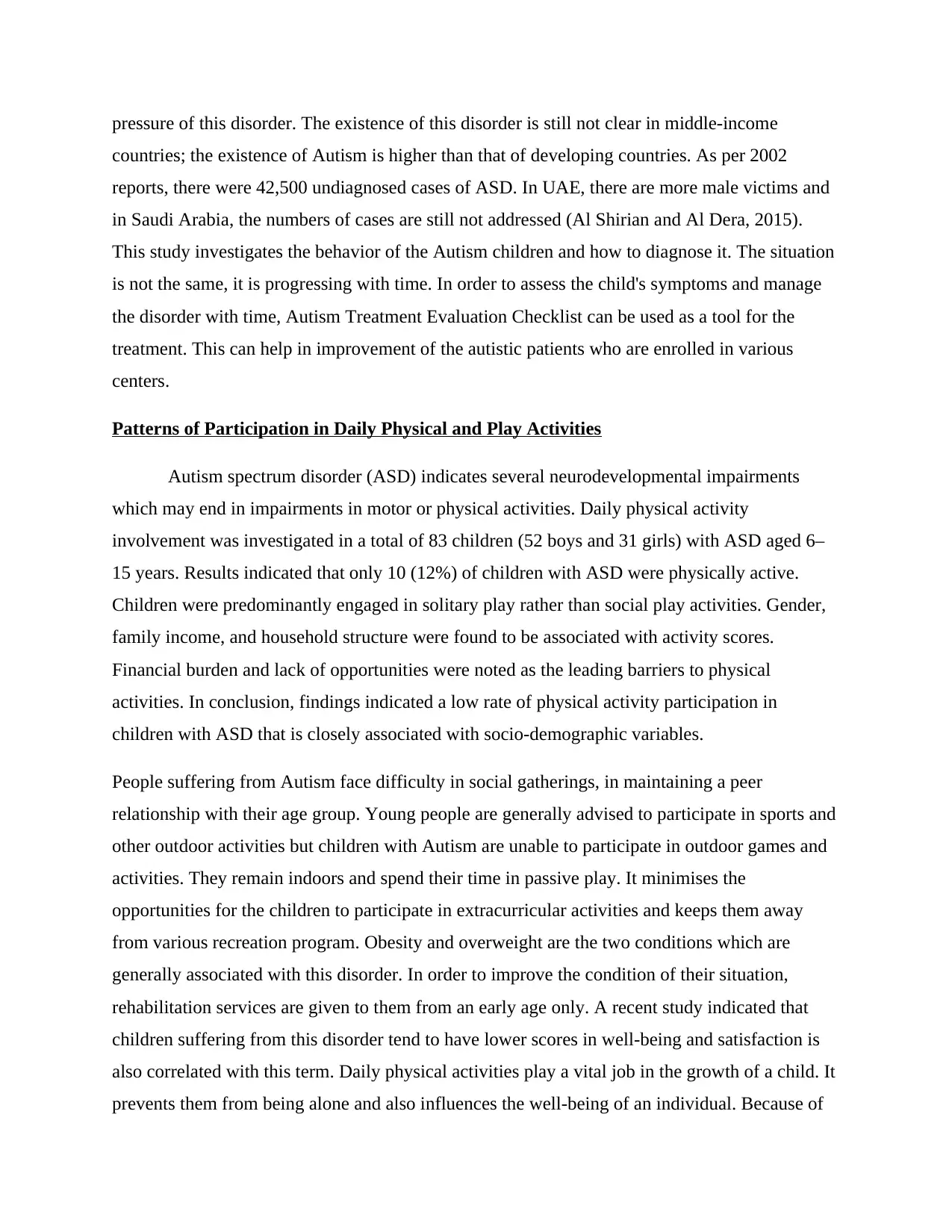
pressure of this disorder. The existence of this disorder is still not clear in middle-income
countries; the existence of Autism is higher than that of developing countries. As per 2002
reports, there were 42,500 undiagnosed cases of ASD. In UAE, there are more male victims and
in Saudi Arabia, the numbers of cases are still not addressed (Al Shirian and Al Dera, 2015).
This study investigates the behavior of the Autism children and how to diagnose it. The situation
is not the same, it is progressing with time. In order to assess the child's symptoms and manage
the disorder with time, Autism Treatment Evaluation Checklist can be used as a tool for the
treatment. This can help in improvement of the autistic patients who are enrolled in various
centers.
Patterns of Participation in Daily Physical and Play Activities
Autism spectrum disorder (ASD) indicates several neurodevelopmental impairments
which may end in impairments in motor or physical activities. Daily physical activity
involvement was investigated in a total of 83 children (52 boys and 31 girls) with ASD aged 6–
15 years. Results indicated that only 10 (12%) of children with ASD were physically active.
Children were predominantly engaged in solitary play rather than social play activities. Gender,
family income, and household structure were found to be associated with activity scores.
Financial burden and lack of opportunities were noted as the leading barriers to physical
activities. In conclusion, findings indicated a low rate of physical activity participation in
children with ASD that is closely associated with socio-demographic variables.
People suffering from Autism face difficulty in social gatherings, in maintaining a peer
relationship with their age group. Young people are generally advised to participate in sports and
other outdoor activities but children with Autism are unable to participate in outdoor games and
activities. They remain indoors and spend their time in passive play. It minimises the
opportunities for the children to participate in extracurricular activities and keeps them away
from various recreation program. Obesity and overweight are the two conditions which are
generally associated with this disorder. In order to improve the condition of their situation,
rehabilitation services are given to them from an early age only. A recent study indicated that
children suffering from this disorder tend to have lower scores in well-being and satisfaction is
also correlated with this term. Daily physical activities play a vital job in the growth of a child. It
prevents them from being alone and also influences the well-being of an individual. Because of
countries; the existence of Autism is higher than that of developing countries. As per 2002
reports, there were 42,500 undiagnosed cases of ASD. In UAE, there are more male victims and
in Saudi Arabia, the numbers of cases are still not addressed (Al Shirian and Al Dera, 2015).
This study investigates the behavior of the Autism children and how to diagnose it. The situation
is not the same, it is progressing with time. In order to assess the child's symptoms and manage
the disorder with time, Autism Treatment Evaluation Checklist can be used as a tool for the
treatment. This can help in improvement of the autistic patients who are enrolled in various
centers.
Patterns of Participation in Daily Physical and Play Activities
Autism spectrum disorder (ASD) indicates several neurodevelopmental impairments
which may end in impairments in motor or physical activities. Daily physical activity
involvement was investigated in a total of 83 children (52 boys and 31 girls) with ASD aged 6–
15 years. Results indicated that only 10 (12%) of children with ASD were physically active.
Children were predominantly engaged in solitary play rather than social play activities. Gender,
family income, and household structure were found to be associated with activity scores.
Financial burden and lack of opportunities were noted as the leading barriers to physical
activities. In conclusion, findings indicated a low rate of physical activity participation in
children with ASD that is closely associated with socio-demographic variables.
People suffering from Autism face difficulty in social gatherings, in maintaining a peer
relationship with their age group. Young people are generally advised to participate in sports and
other outdoor activities but children with Autism are unable to participate in outdoor games and
activities. They remain indoors and spend their time in passive play. It minimises the
opportunities for the children to participate in extracurricular activities and keeps them away
from various recreation program. Obesity and overweight are the two conditions which are
generally associated with this disorder. In order to improve the condition of their situation,
rehabilitation services are given to them from an early age only. A recent study indicated that
children suffering from this disorder tend to have lower scores in well-being and satisfaction is
also correlated with this term. Daily physical activities play a vital job in the growth of a child. It
prevents them from being alone and also influences the well-being of an individual. Because of
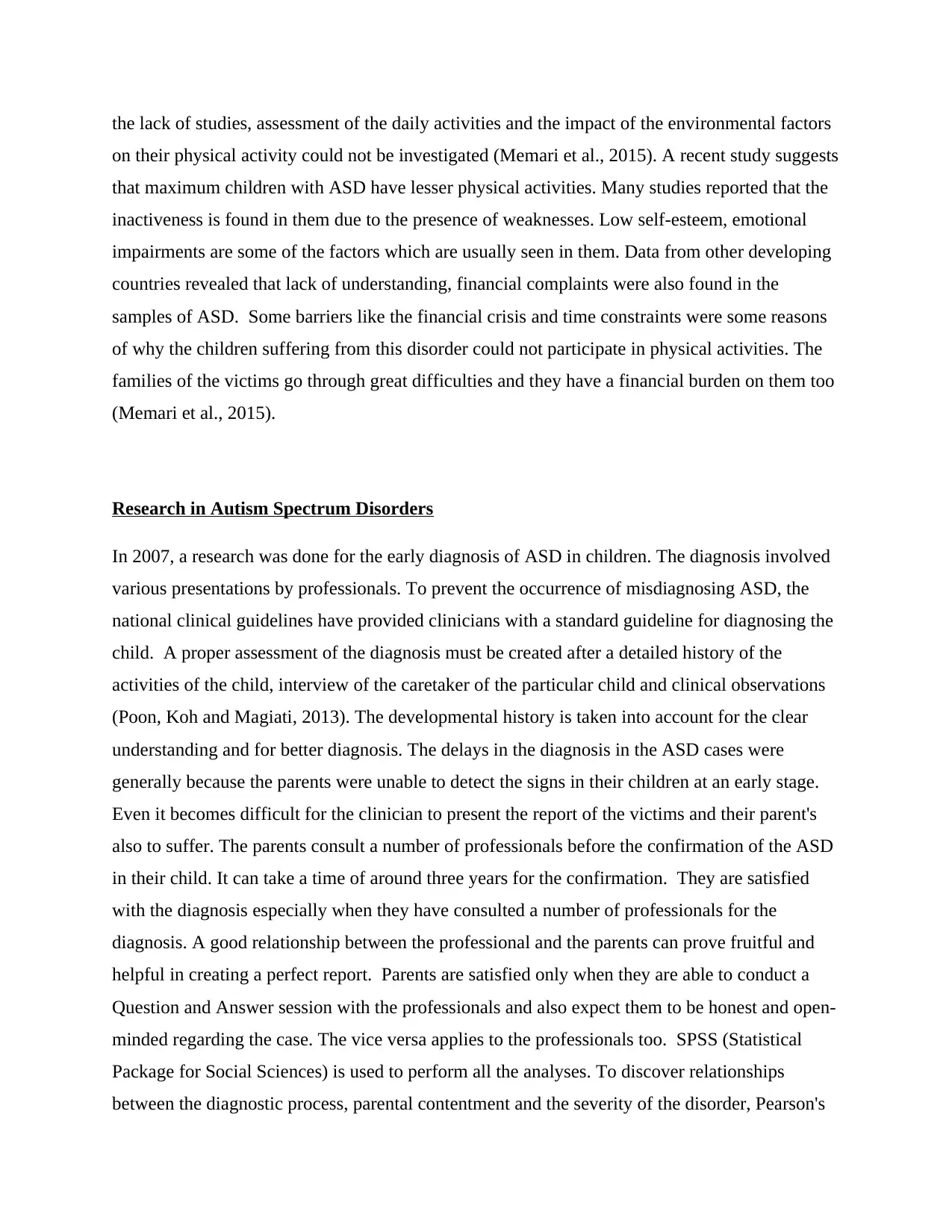
the lack of studies, assessment of the daily activities and the impact of the environmental factors
on their physical activity could not be investigated (Memari et al., 2015). A recent study suggests
that maximum children with ASD have lesser physical activities. Many studies reported that the
inactiveness is found in them due to the presence of weaknesses. Low self-esteem, emotional
impairments are some of the factors which are usually seen in them. Data from other developing
countries revealed that lack of understanding, financial complaints were also found in the
samples of ASD. Some barriers like the financial crisis and time constraints were some reasons
of why the children suffering from this disorder could not participate in physical activities. The
families of the victims go through great difficulties and they have a financial burden on them too
(Memari et al., 2015).
Research in Autism Spectrum Disorders
In 2007, a research was done for the early diagnosis of ASD in children. The diagnosis involved
various presentations by professionals. To prevent the occurrence of misdiagnosing ASD, the
national clinical guidelines have provided clinicians with a standard guideline for diagnosing the
child. A proper assessment of the diagnosis must be created after a detailed history of the
activities of the child, interview of the caretaker of the particular child and clinical observations
(Poon, Koh and Magiati, 2013). The developmental history is taken into account for the clear
understanding and for better diagnosis. The delays in the diagnosis in the ASD cases were
generally because the parents were unable to detect the signs in their children at an early stage.
Even it becomes difficult for the clinician to present the report of the victims and their parent's
also to suffer. The parents consult a number of professionals before the confirmation of the ASD
in their child. It can take a time of around three years for the confirmation. They are satisfied
with the diagnosis especially when they have consulted a number of professionals for the
diagnosis. A good relationship between the professional and the parents can prove fruitful and
helpful in creating a perfect report. Parents are satisfied only when they are able to conduct a
Question and Answer session with the professionals and also expect them to be honest and open-
minded regarding the case. The vice versa applies to the professionals too. SPSS (Statistical
Package for Social Sciences) is used to perform all the analyses. To discover relationships
between the diagnostic process, parental contentment and the severity of the disorder, Pearson's
on their physical activity could not be investigated (Memari et al., 2015). A recent study suggests
that maximum children with ASD have lesser physical activities. Many studies reported that the
inactiveness is found in them due to the presence of weaknesses. Low self-esteem, emotional
impairments are some of the factors which are usually seen in them. Data from other developing
countries revealed that lack of understanding, financial complaints were also found in the
samples of ASD. Some barriers like the financial crisis and time constraints were some reasons
of why the children suffering from this disorder could not participate in physical activities. The
families of the victims go through great difficulties and they have a financial burden on them too
(Memari et al., 2015).
Research in Autism Spectrum Disorders
In 2007, a research was done for the early diagnosis of ASD in children. The diagnosis involved
various presentations by professionals. To prevent the occurrence of misdiagnosing ASD, the
national clinical guidelines have provided clinicians with a standard guideline for diagnosing the
child. A proper assessment of the diagnosis must be created after a detailed history of the
activities of the child, interview of the caretaker of the particular child and clinical observations
(Poon, Koh and Magiati, 2013). The developmental history is taken into account for the clear
understanding and for better diagnosis. The delays in the diagnosis in the ASD cases were
generally because the parents were unable to detect the signs in their children at an early stage.
Even it becomes difficult for the clinician to present the report of the victims and their parent's
also to suffer. The parents consult a number of professionals before the confirmation of the ASD
in their child. It can take a time of around three years for the confirmation. They are satisfied
with the diagnosis especially when they have consulted a number of professionals for the
diagnosis. A good relationship between the professional and the parents can prove fruitful and
helpful in creating a perfect report. Parents are satisfied only when they are able to conduct a
Question and Answer session with the professionals and also expect them to be honest and open-
minded regarding the case. The vice versa applies to the professionals too. SPSS (Statistical
Package for Social Sciences) is used to perform all the analyses. To discover relationships
between the diagnostic process, parental contentment and the severity of the disorder, Pearson's
Secure Best Marks with AI Grader
Need help grading? Try our AI Grader for instant feedback on your assignments.
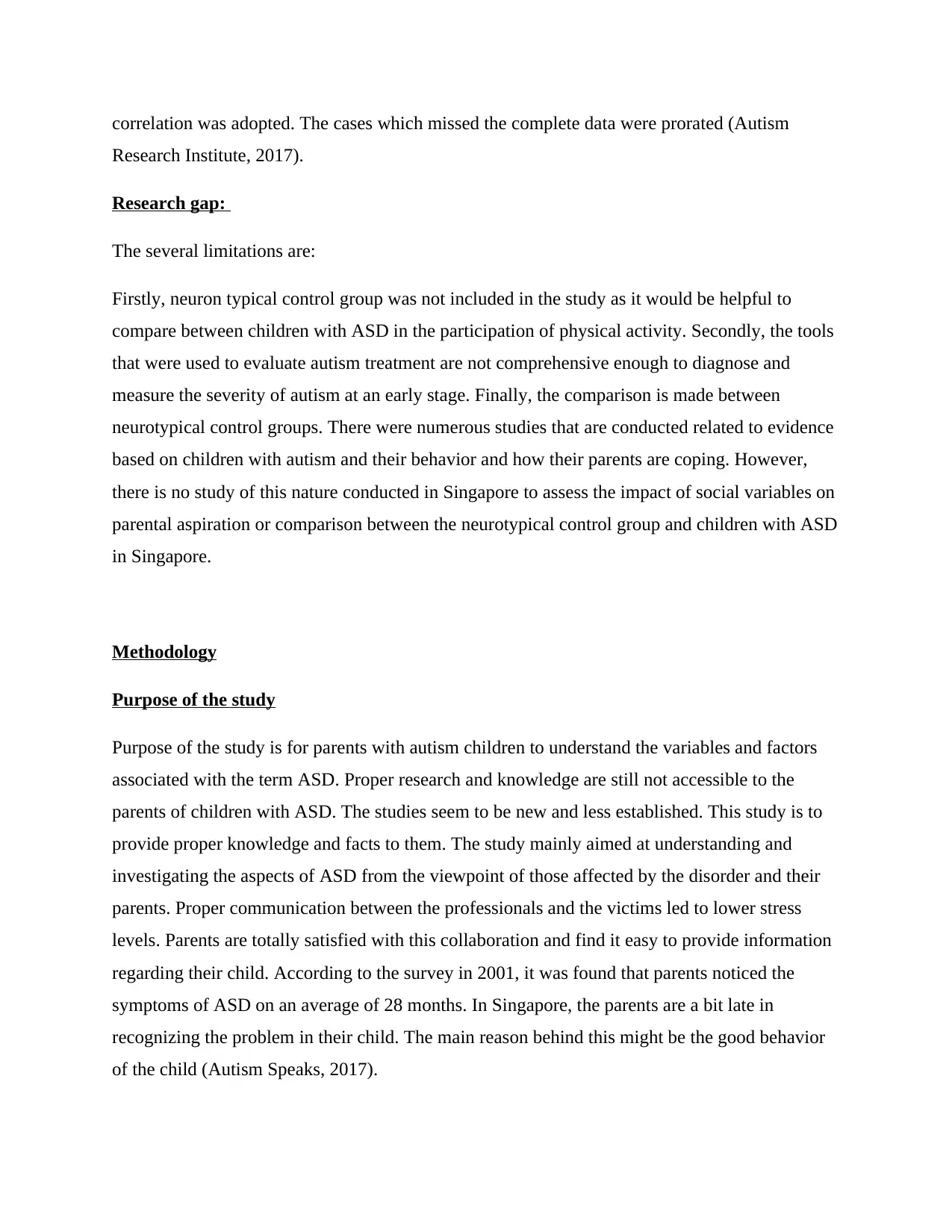
correlation was adopted. The cases which missed the complete data were prorated (Autism
Research Institute, 2017).
Research gap:
The several limitations are:
Firstly, neuron typical control group was not included in the study as it would be helpful to
compare between children with ASD in the participation of physical activity. Secondly, the tools
that were used to evaluate autism treatment are not comprehensive enough to diagnose and
measure the severity of autism at an early stage. Finally, the comparison is made between
neurotypical control groups. There were numerous studies that are conducted related to evidence
based on children with autism and their behavior and how their parents are coping. However,
there is no study of this nature conducted in Singapore to assess the impact of social variables on
parental aspiration or comparison between the neurotypical control group and children with ASD
in Singapore.
Methodology
Purpose of the study
Purpose of the study is for parents with autism children to understand the variables and factors
associated with the term ASD. Proper research and knowledge are still not accessible to the
parents of children with ASD. The studies seem to be new and less established. This study is to
provide proper knowledge and facts to them. The study mainly aimed at understanding and
investigating the aspects of ASD from the viewpoint of those affected by the disorder and their
parents. Proper communication between the professionals and the victims led to lower stress
levels. Parents are totally satisfied with this collaboration and find it easy to provide information
regarding their child. According to the survey in 2001, it was found that parents noticed the
symptoms of ASD on an average of 28 months. In Singapore, the parents are a bit late in
recognizing the problem in their child. The main reason behind this might be the good behavior
of the child (Autism Speaks, 2017).
Research Institute, 2017).
Research gap:
The several limitations are:
Firstly, neuron typical control group was not included in the study as it would be helpful to
compare between children with ASD in the participation of physical activity. Secondly, the tools
that were used to evaluate autism treatment are not comprehensive enough to diagnose and
measure the severity of autism at an early stage. Finally, the comparison is made between
neurotypical control groups. There were numerous studies that are conducted related to evidence
based on children with autism and their behavior and how their parents are coping. However,
there is no study of this nature conducted in Singapore to assess the impact of social variables on
parental aspiration or comparison between the neurotypical control group and children with ASD
in Singapore.
Methodology
Purpose of the study
Purpose of the study is for parents with autism children to understand the variables and factors
associated with the term ASD. Proper research and knowledge are still not accessible to the
parents of children with ASD. The studies seem to be new and less established. This study is to
provide proper knowledge and facts to them. The study mainly aimed at understanding and
investigating the aspects of ASD from the viewpoint of those affected by the disorder and their
parents. Proper communication between the professionals and the victims led to lower stress
levels. Parents are totally satisfied with this collaboration and find it easy to provide information
regarding their child. According to the survey in 2001, it was found that parents noticed the
symptoms of ASD on an average of 28 months. In Singapore, the parents are a bit late in
recognizing the problem in their child. The main reason behind this might be the good behavior
of the child (Autism Speaks, 2017).

PICO
P: ASD children and parents or families with autistic kids
I: family guidance programs
C: Parents with ASD children who receive professional guidance
O:
IV :
DV:
Hypothesis
(1) Identification of ASD is done in an early age of eighteen months to eight years old child. It
becomes easy to diagnose the disorder as early as possible because it would be difficult after a
certain age.
(2) The parents of the ASD victims who receive professional guidance and follow their
instructions are likely to benefit more than the ones who are reluctant to contact the professionals
(Autism, 2000).
Research Design
A detailed history of the patients and discussions with their parents must be conducted before
taking proper steps for the treatment of a disorder.
(I) Control group would be supervised by the professionals if children are diagnosed
with ASD during the course of study.
(II) The professionals would engage in the betterment of the children by engaging them
in outdoor sports and other extracurricular activities. The use of medication and physical exercise
must be a crucial part.
Sample Characteristics
P: ASD children and parents or families with autistic kids
I: family guidance programs
C: Parents with ASD children who receive professional guidance
O:
IV :
DV:
Hypothesis
(1) Identification of ASD is done in an early age of eighteen months to eight years old child. It
becomes easy to diagnose the disorder as early as possible because it would be difficult after a
certain age.
(2) The parents of the ASD victims who receive professional guidance and follow their
instructions are likely to benefit more than the ones who are reluctant to contact the professionals
(Autism, 2000).
Research Design
A detailed history of the patients and discussions with their parents must be conducted before
taking proper steps for the treatment of a disorder.
(I) Control group would be supervised by the professionals if children are diagnosed
with ASD during the course of study.
(II) The professionals would engage in the betterment of the children by engaging them
in outdoor sports and other extracurricular activities. The use of medication and physical exercise
must be a crucial part.
Sample Characteristics
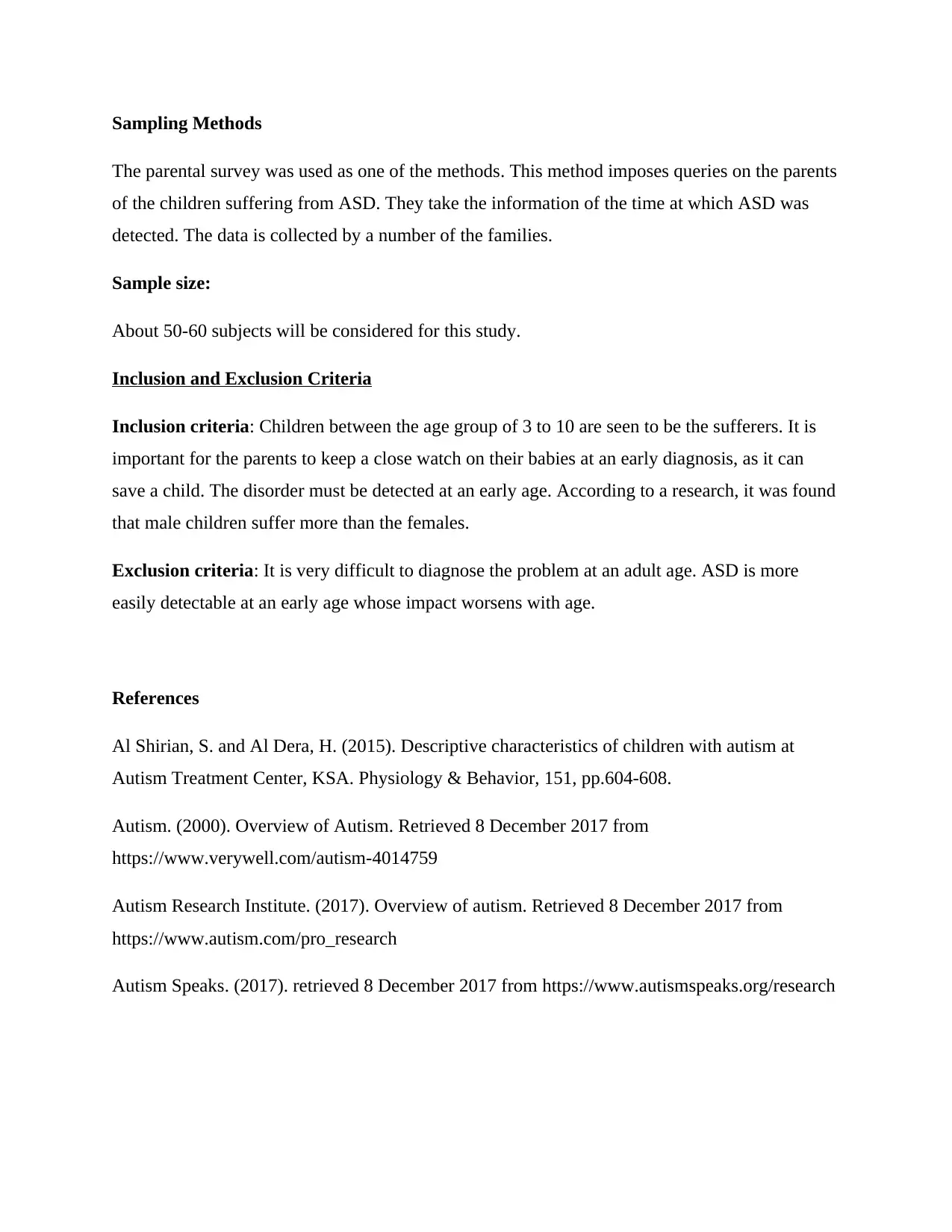
Sampling Methods
The parental survey was used as one of the methods. This method imposes queries on the parents
of the children suffering from ASD. They take the information of the time at which ASD was
detected. The data is collected by a number of the families.
Sample size:
About 50-60 subjects will be considered for this study.
Inclusion and Exclusion Criteria
Inclusion criteria: Children between the age group of 3 to 10 are seen to be the sufferers. It is
important for the parents to keep a close watch on their babies at an early diagnosis, as it can
save a child. The disorder must be detected at an early age. According to a research, it was found
that male children suffer more than the females.
Exclusion criteria: It is very difficult to diagnose the problem at an adult age. ASD is more
easily detectable at an early age whose impact worsens with age.
References
Al Shirian, S. and Al Dera, H. (2015). Descriptive characteristics of children with autism at
Autism Treatment Center, KSA. Physiology & Behavior, 151, pp.604-608.
Autism. (2000). Overview of Autism. Retrieved 8 December 2017 from
https://www.verywell.com/autism-4014759
Autism Research Institute. (2017). Overview of autism. Retrieved 8 December 2017 from
https://www.autism.com/pro_research
Autism Speaks. (2017). retrieved 8 December 2017 from https://www.autismspeaks.org/research
The parental survey was used as one of the methods. This method imposes queries on the parents
of the children suffering from ASD. They take the information of the time at which ASD was
detected. The data is collected by a number of the families.
Sample size:
About 50-60 subjects will be considered for this study.
Inclusion and Exclusion Criteria
Inclusion criteria: Children between the age group of 3 to 10 are seen to be the sufferers. It is
important for the parents to keep a close watch on their babies at an early diagnosis, as it can
save a child. The disorder must be detected at an early age. According to a research, it was found
that male children suffer more than the females.
Exclusion criteria: It is very difficult to diagnose the problem at an adult age. ASD is more
easily detectable at an early age whose impact worsens with age.
References
Al Shirian, S. and Al Dera, H. (2015). Descriptive characteristics of children with autism at
Autism Treatment Center, KSA. Physiology & Behavior, 151, pp.604-608.
Autism. (2000). Overview of Autism. Retrieved 8 December 2017 from
https://www.verywell.com/autism-4014759
Autism Research Institute. (2017). Overview of autism. Retrieved 8 December 2017 from
https://www.autism.com/pro_research
Autism Speaks. (2017). retrieved 8 December 2017 from https://www.autismspeaks.org/research
Paraphrase This Document
Need a fresh take? Get an instant paraphrase of this document with our AI Paraphraser
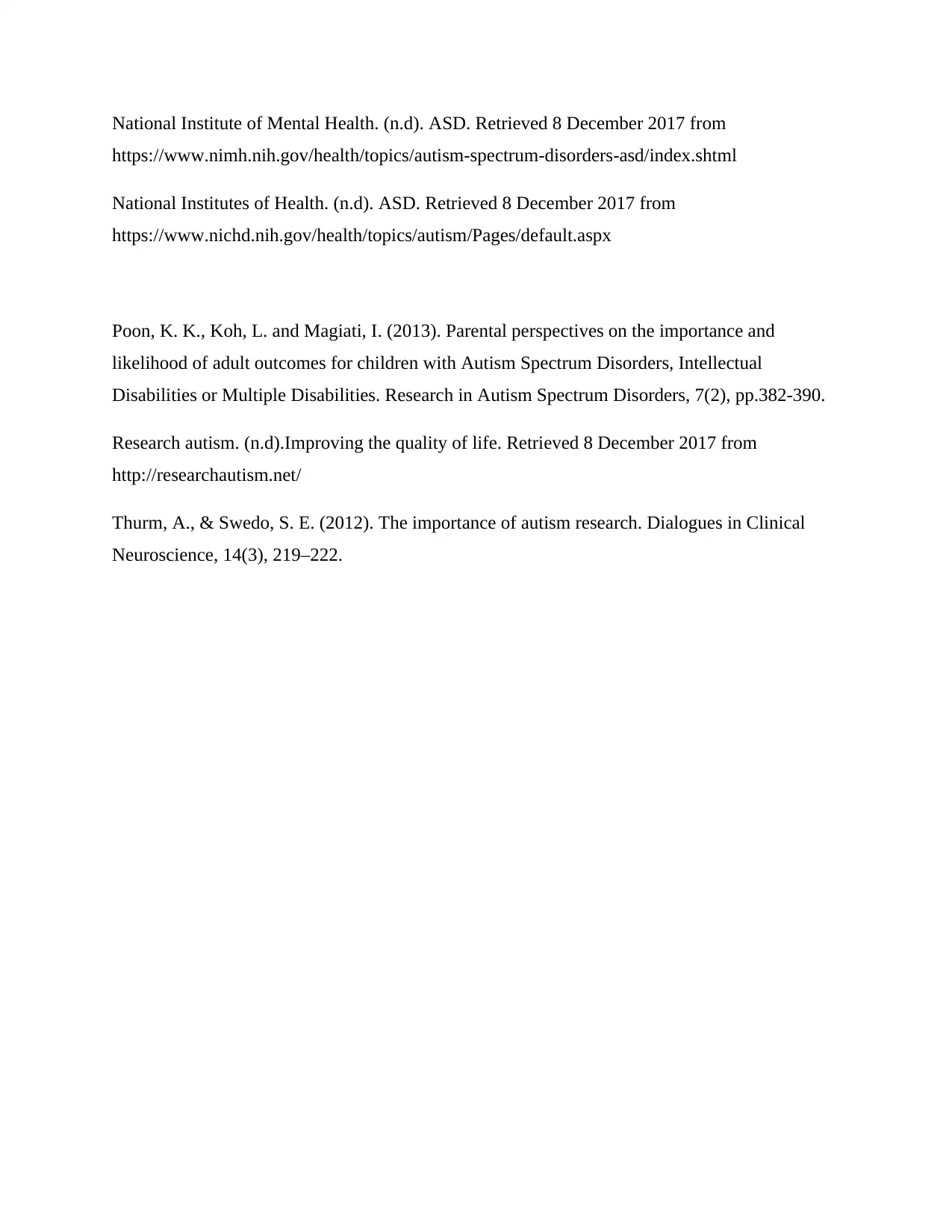
National Institute of Mental Health. (n.d). ASD. Retrieved 8 December 2017 from
https://www.nimh.nih.gov/health/topics/autism-spectrum-disorders-asd/index.shtml
National Institutes of Health. (n.d). ASD. Retrieved 8 December 2017 from
https://www.nichd.nih.gov/health/topics/autism/Pages/default.aspx
Poon, K. K., Koh, L. and Magiati, I. (2013). Parental perspectives on the importance and
likelihood of adult outcomes for children with Autism Spectrum Disorders, Intellectual
Disabilities or Multiple Disabilities. Research in Autism Spectrum Disorders, 7(2), pp.382-390.
Research autism. (n.d).Improving the quality of life. Retrieved 8 December 2017 from
http://researchautism.net/
Thurm, A., & Swedo, S. E. (2012). The importance of autism research. Dialogues in Clinical
Neuroscience, 14(3), 219–222.
https://www.nimh.nih.gov/health/topics/autism-spectrum-disorders-asd/index.shtml
National Institutes of Health. (n.d). ASD. Retrieved 8 December 2017 from
https://www.nichd.nih.gov/health/topics/autism/Pages/default.aspx
Poon, K. K., Koh, L. and Magiati, I. (2013). Parental perspectives on the importance and
likelihood of adult outcomes for children with Autism Spectrum Disorders, Intellectual
Disabilities or Multiple Disabilities. Research in Autism Spectrum Disorders, 7(2), pp.382-390.
Research autism. (n.d).Improving the quality of life. Retrieved 8 December 2017 from
http://researchautism.net/
Thurm, A., & Swedo, S. E. (2012). The importance of autism research. Dialogues in Clinical
Neuroscience, 14(3), 219–222.
1 out of 8
Related Documents
Your All-in-One AI-Powered Toolkit for Academic Success.
+13062052269
info@desklib.com
Available 24*7 on WhatsApp / Email
![[object Object]](/_next/static/media/star-bottom.7253800d.svg)
Unlock your academic potential
© 2024 | Zucol Services PVT LTD | All rights reserved.




